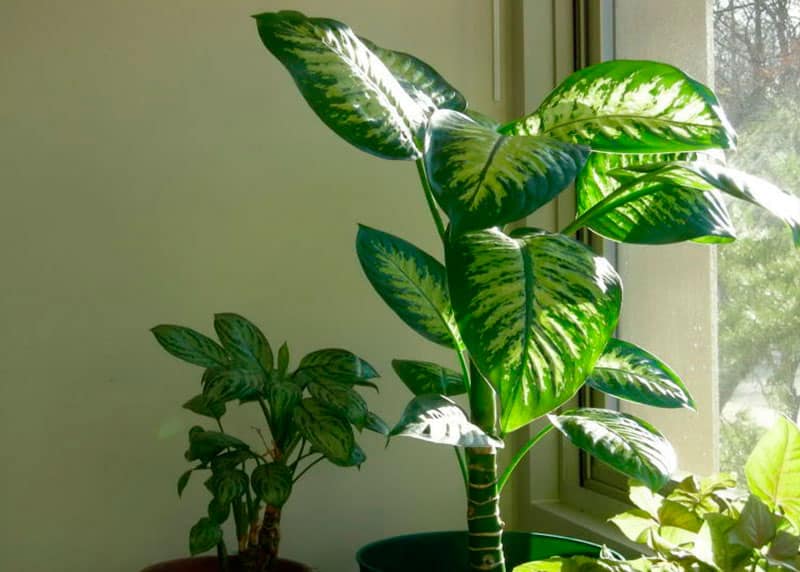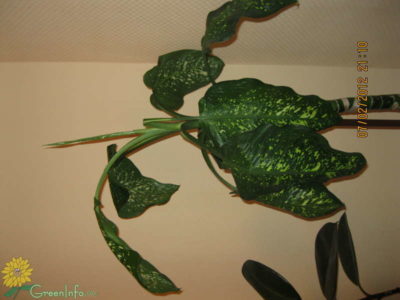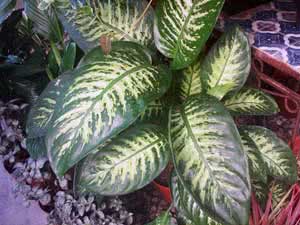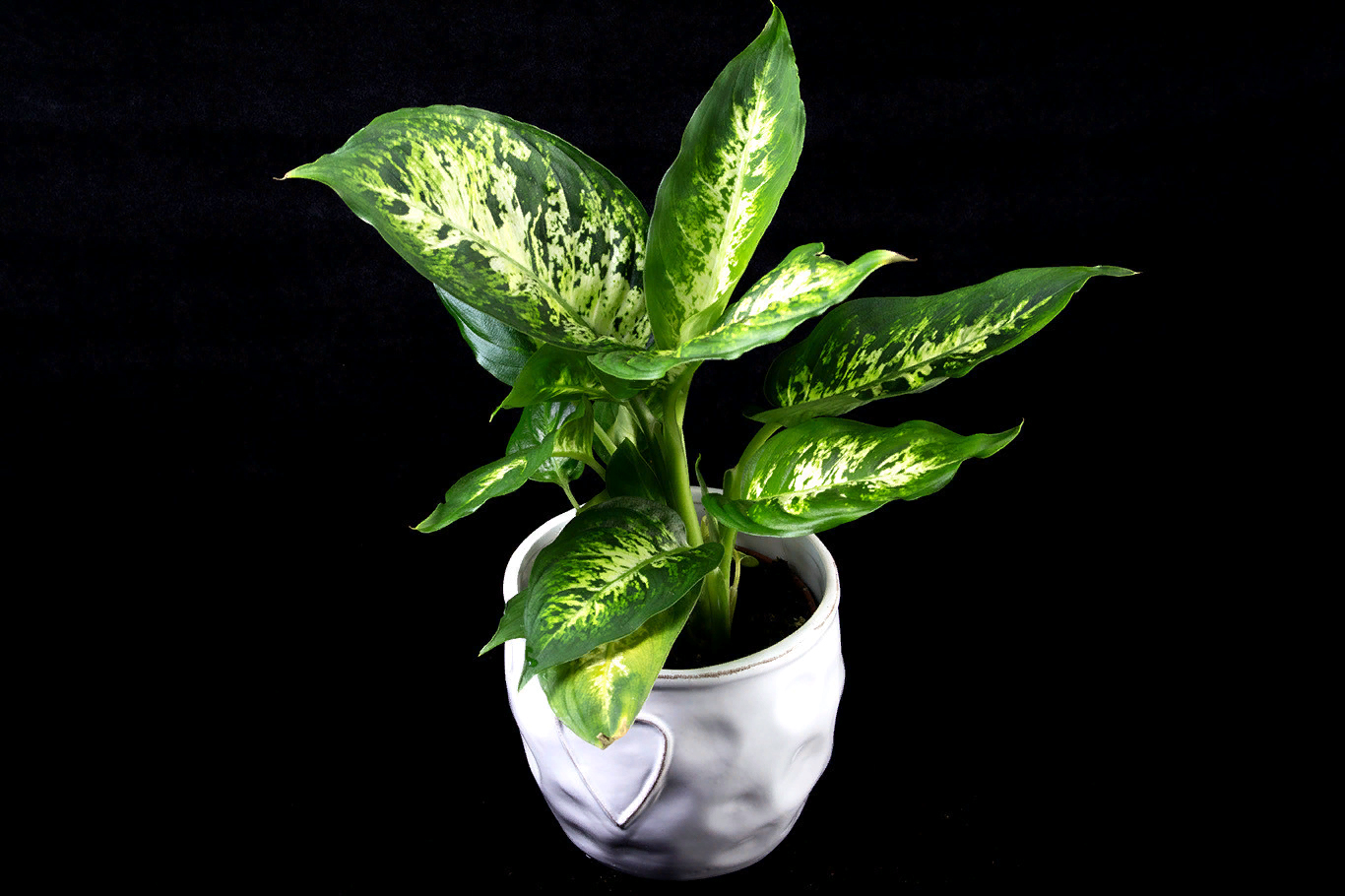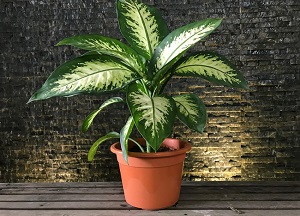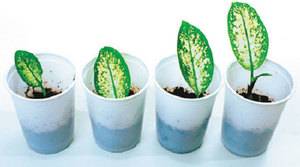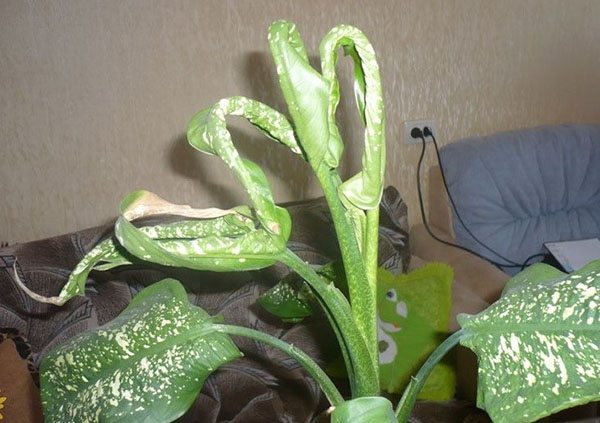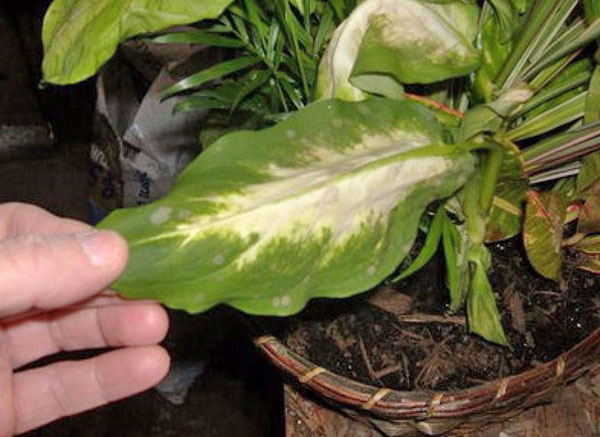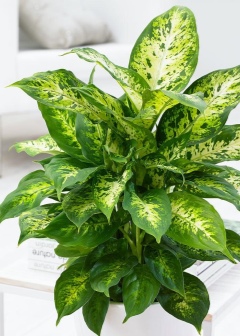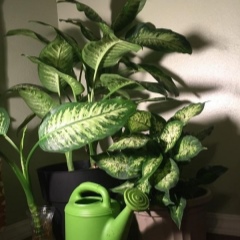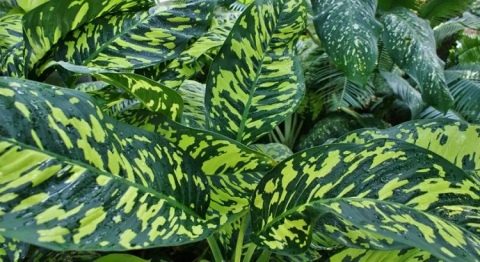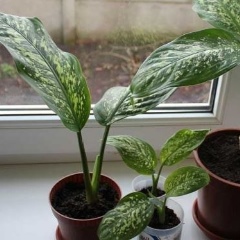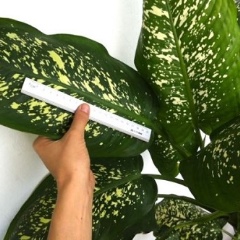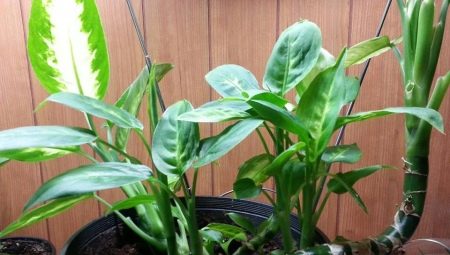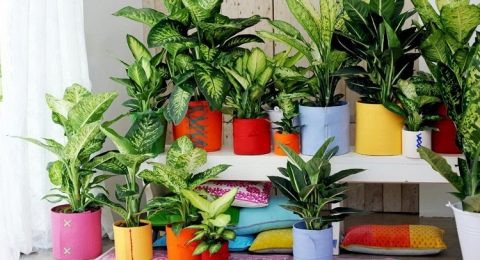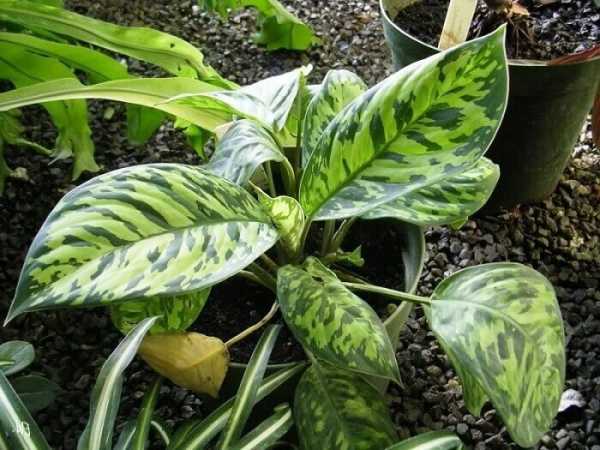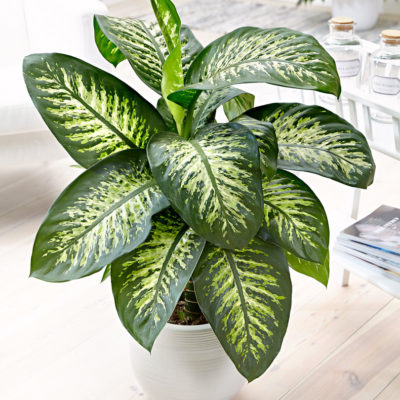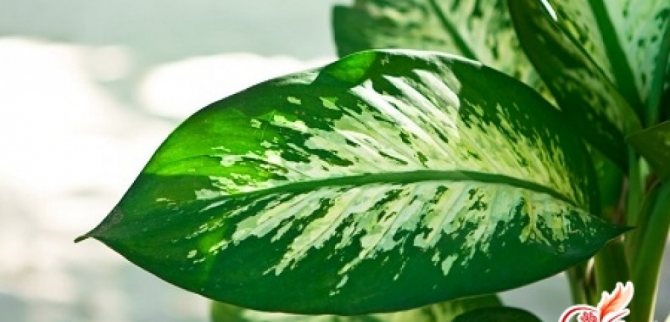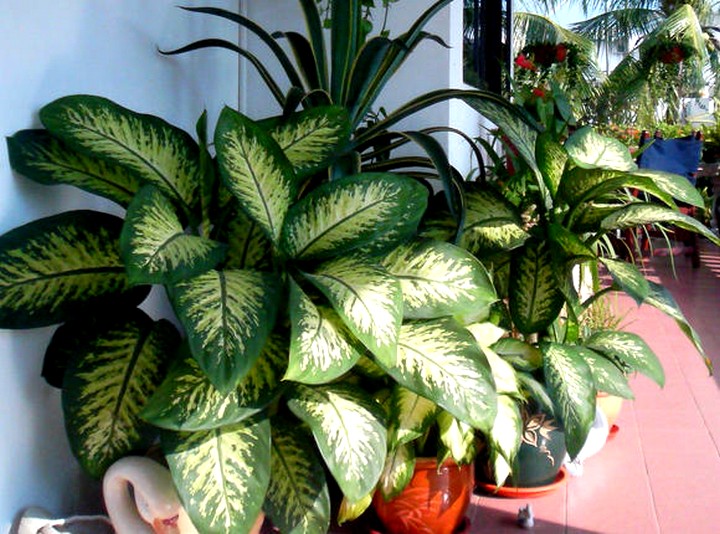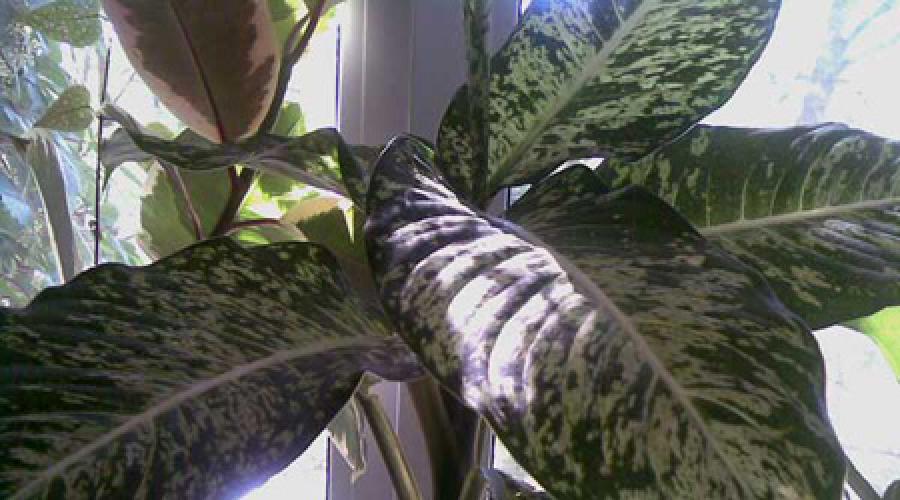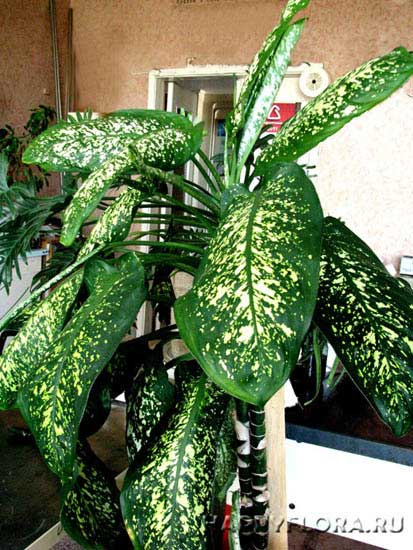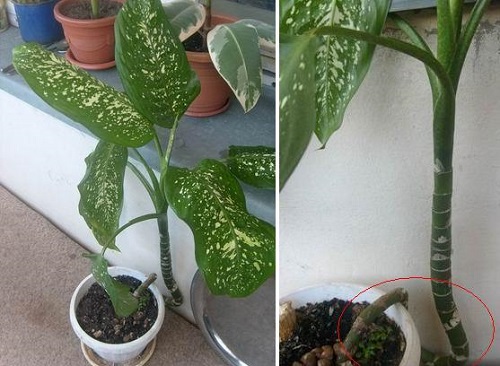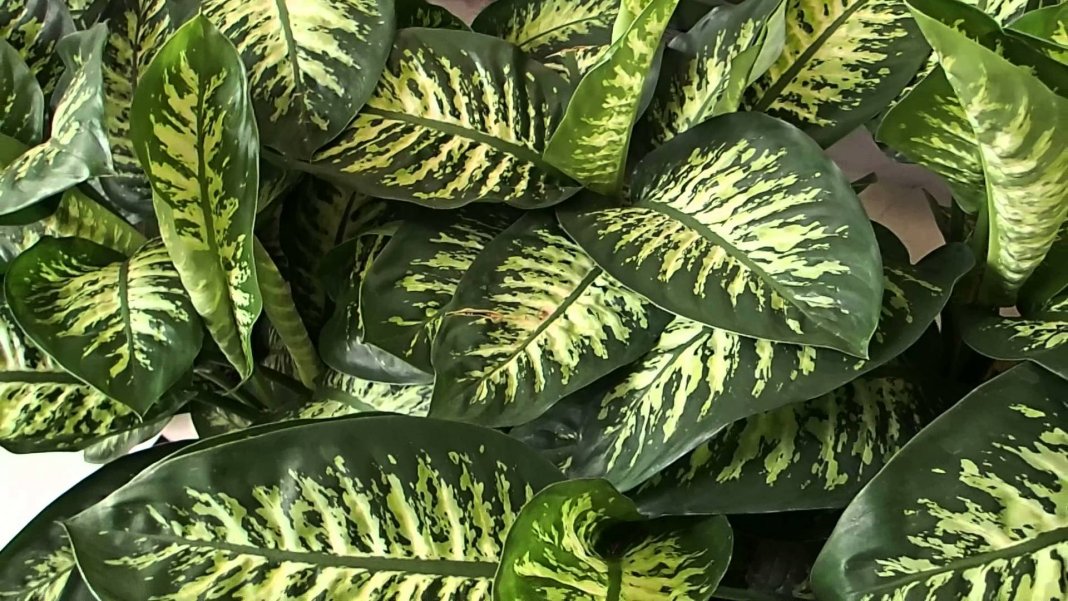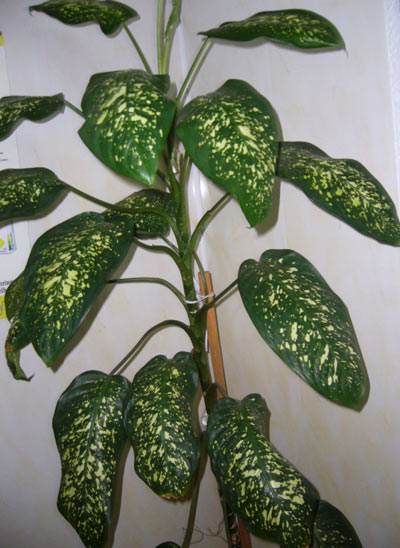Types and varieties of dieffenbachia
The most common species in culture are Dieffenbachia maculata and Dieffenbachia picta - plants with a large succulent stem and elongated oval leaf plates with obvious venation, reaching 12 cm in width and up to half a meter in length. Their bright green leaves are dotted with white spots and stripes. They differ from each other in that variegated dieffenbachia grows up to two meters in height, and spotted dieffenbachia does not exceed a meter, but its leaves are slightly larger in size and they are more pointed at the top. It was the spotted dieffenbachia that became the basis for most of the varieties and hybrids bred by breeders. Here are some of the most popular varieties of Dieffenbachia spotted in the culture:
- variety "Vesuvio" - a graceful medium-sized plant with narrow, delicate white leaves and green specks on white petioles;
- Dieffenbachia "Camilla" is one of the most hardy bushy varieties, which is why it has earned popularity among amateurs. Lanceolate creamy white leaves are surrounded by a light green rim. Young leaves are greenish;
- Dieffenbachia "Compact" is a neat dense bush with green leaves with light specks along the central vein.
Dieffenbachia leopoldii
A low-growing plant native to Costa Rica with a short and thick stem, pale green short petioles with purple spots and dark green elliptical leaves up to 35 cm long with a pronounced white central vein.
Dieffenbachia adorable, or pleasant (Dieffenbachia amoena)
Lovers of flowers like it for its unpretentiousness and excellent adaptability to home conditions, since it tolerates dry air and the proximity of heating devices better than other species. In addition, its decorative qualities are beyond any criticism: height up to one and a half meters, large dark green oval leaves up to 60 cm long with white stripes along all the veins.
Dieffenbachia seguina
Which amateurs often confuse with spotted dieffenbachia, has wider - up to 16 cm - leaves with fewer lateral veins than that of spotted dieffenbachia. This species also gave many varieties and hybrids, for example, "Tropic Snow" - never out of fashion cultivar with the correct pattern on the leaves formed by yellow spots, while the central vein and edges of the leaves remain dark green.
Dieffenbachia oerstedii
View with monochromatic green leaves of a cordate or pointed shape with a distinct light central vein. The leaves are 30-35 cm long. The most famous hybrid of this species is "Green Magic", a dense small bush with unusual color leaves: they are dark bluish-green with a white central vein. There is a form with small light specks along the leaf blade.
Dieffenbachia macrophylla
The only species with monochromatic green leaves and veins, the shape of the leaf plate is ovoid, the median vein is thickened. This species grows in height up to one meter.
The main factors of correct content
There are three risk factors - improper plant care, pests and diseases. The decisive factor is leaving. If the leaves of dieffenbachia turn yellow, this is a signal of trouble. If, at the first sign, the problem is eliminated, the plant will recover, and will delight with beauty for a long time.
Errors in care include unacceptable conditions for a flower:
- Summer illumination through a tulle curtain is quite comfortable for the plant. In winter, dieffenbachia requires additional lighting, the duration of daylight should be at least 10 hours. With a lack of light, the leaves turn pale, then turn yellow. The sun's rays create necrotic spots.
- Watering with hard water will lead to pallor, and then to yellowness of the leaves.The water should be soft, feeding with Ferrovit with pale leaves, like an ambulance. The leaves will turn brown and dry out if the plant is dry. But why do all the leaves of Dieffenbachia turn yellow at once and suddenly? The plant is flooded, the ground is acidic, the roots rot and do not work. If the rot is not removed and the plant is not transplanted into a new substrate, it will dry out in a few days.
- The soil mixture should be fertile, loose and slightly acidic. In dense soil, with disturbed acidity, salts from the soil are not assimilated. Growth will slow down, the lower leaves will turn yellow. This will be a sign of an imbalanced nutrient balance in the soil. If the yellowness starts from the top, vitamin supplementation is required with a balanced composition for decorative deciduous plants.
- The temperature for a dieffenbachia indoor flower should be even, without sudden changes. If there is a short-term decrease to 10-12 degrees, then the plant will survive, but the leaves will gradually turn yellow and fall off. Drafts will also lead to yellowing of the plate, its drying. This phenomenon is called necrosis.
It should be borne in mind that the plant does not immediately react to an offense, changes occur a week or two after the blow is received
And every such inattention weakens the flower. After that, dieffenbachia is affected by diseases, it becomes a source of food for pests
Dieffenbachia pests are:
On this topic:
BACK
FORWARD
1 of 4
- spider mite;
- shield;
- aphid.
On this topic:
BACK
FORWARD
1 of 3
All of them feed on plant juices, gradually destroying it. With frequent spraying of the leaves and wiping them with a damp cloth, the tick will not start. He loves dry air. But if the care is negligent, then punctures on the leaves and their yellowing will become noticeable. Reproducing very quickly, the mite will populate all plants. Why do dieffenbachia leaves turn yellow from colonization of a tick? It multiplies rapidly and sucks the juice out of the leaf. If you don't fight, the plant will die.
The scabbard is located on the stems and veins, looks like brown spots, is removed with an alcohol-soap solution. Aphids are washed off, cleaned with soapy water. But if there are a lot of insects, then you have to use a chemical.
The consequences of poisoning
Dieffenbachia intoxication can contribute to the development of complications. The contact with the poison on the skin is usually limited by a local reaction and quickly passes with the correct treatment algorithm. Prevention of skin burns is simple and involves the use of protective gloves.
A burn of the oral cavity causes more consequences. The mucous membrane contains many vessels and one of the body's defenses is an increase in blood flow with the formation of edema. Localizing the burn can lead to breathing difficulties. Potential consequences - laryngitis with a change in the timbre of the voice, inflammation of the bronchi, pneumonia. The condition is further aggravated by swelling of the nasal mucosa.
If dieffenbachia juice gets into the eye, the prognosis for preserving vision and restoring tissues depends on the volume and speed of first aid and specialized medical care. Corneal healing can result in loss of transparency and the formation of a leucorrhoea.
Allergic reactions, even of a local nature, lead to the development of a terminal state. You should not indulge yourself with the fact that several times the problem was bypassed only by irritation of the skin or mucous membranes. The more such cases, the higher the possibility of developing an allergic reaction.
If in relation to adults one can count on caution and prudence, then for children the degree of risk remains high.
Dieffenbachia is a poisonous plant that is often used as a decorative element in interior design. Fans put forward more than one argument in favor of growing Dieffenbachia at home. For example, the ability to improve humidity and air composition, and not only physical, but also energetic. However, the proven fact of the toxicity of the juice outweighs by its severity many of the beneficial properties of the plant.Dieffenbachia on contact causes burns to the skin, oral mucosa, eyes, indigestion
Adults can exercise caution, follow simple rules of prevention, but they are responsible for poisoning children. There are cases when babies get painful burns, disorders of the gastrointestinal tract when biting off and swallowing leaves and stems of a plant
Bringing a poisonous flower into the house, you should organize the life of the child and dieffenbachia so that they do not intersect, do not contact. Every adult must honestly answer to himself the question of whether it is possible to keep dieffenbachia in his bedroom and how justified is the risk of harming the health of loved ones, is it worth it to periodically admire the variegated leaves.
Poisonous plant dieffenbachia
How to care for dieffenbachia
Despite the fact that dieffenbachia is a fairly popular flower color among gardeners, it still needs careful care. Plants react extremely negatively to cold and any draft. In addition, regular watering and pruning of plants is necessary for good development.
Dieffenbachia care and watering
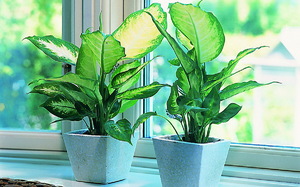
Watering rules
If the water is too hard, the tops of the leaves may turn brown and sometimes even crumble. It is recommended to add oxalic acid to soften the water. In summer, the flower should be watered at least once every 2 days; in winter, it is enough to water once a week.
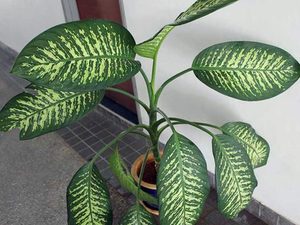
comfortable on a lighted windowsill
The temperature should be maintained. In spring and summer, the temperature should be 20-23 degrees, in winter the temperature should not be lower than 16 degrees. If the temperature is lower, the plant may shed the lower leaves. With a sharp change in temperature, the condition of the flower deteriorates significantly. The air in the room where dieffenbachia is located should be humid and warm. Drafts are undesirable: they cause stress. And also temperatures below 16 degrees are detrimental to plants.

wet moss, sand or gravel
This must be done periodically, but if the temperature is still less than 17 degrees, then it is better not to do this, and instead of spraying, it is better to replace the procedure with wiping with a damp cloth. Once a week, the flower needs to be rinsed with a shower to remove dust.
When transplanting a plant, it is best to use a ready-made substance that is intended for the chokeberry group. You can use soil that has neutral acidity. For this, the following composition is taken:
- 1 piece of leafy land;
- 4 parts of sod land;
- 1 part sand;
- 1 part peat.

Feeding is required throughout the year, since she does not have a specific time to rest. In spring and summer, plants can be fertilized once every 2 weeks, and in winter about once every 12 months. One of the necessary conditions for feeding: the composition should not have lime. Mineral feeding Vita has proven itself well. You can also use other liquid formulations, nitrogen-containing organic fertilizers are useful. However, there should be not very much nitrogen, otherwise the white leaves will turn green.
Aging leaves
Dieffenbachia is a fast-growing plant, so it tends to bare the stem. Do not worry if one lower leaf of the flower has turned yellow and fell off, and this unpleasant defect has not spread to the rest of the plant. This shows that there is a natural process of aging and withering away.
Why do the leaves turn yellow and what to do?
If the flower lacks diffused sunlight, their leaf plates first begin to discolor, lose their beautiful pattern, and then the leaf turns yellow and falls off.
This often happens if the apartment is gloomy enough even in summer due to the foliage of the trees planted outside the window. If it is not possible to transfer Dieffenbachia to another room or put it on the windowsill, then you should think about additional lighting for the flower.

Leaves dry
Leaves can dry out if the plant is over-fed with nitrogen fertilizers. If this happens, the plant will require urgent transplantation into a new substrate with complete flushing of the root system.
Therefore, a new soil is acquired, specially designed for planting a flower in it. New expanded clay is laid out at the bottom, but if there is no way to purchase a new one, then the old one is poured over with boiling water and dried. Dieffenbachia is taken out of the old soil and the roots are washed with warm water. After that, it will already be possible to plant in new soil. It should also be remembered that after transplantation, the flower is not fed for a month.
Drying out the tips of the leaves
Most likely, in Dieffenbachia, watering is not regulated or, during winter keeping, in a room where the plant lives, very dry air.
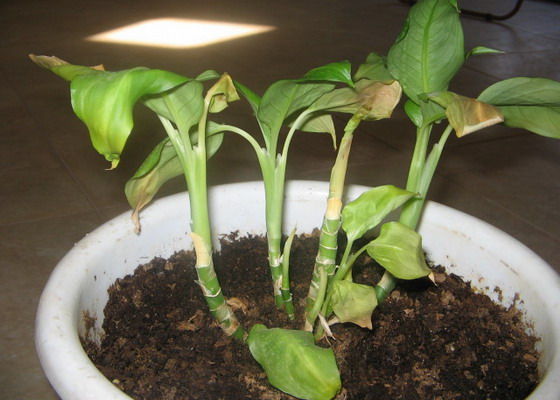
In winter, at low temperatures, the tips of the leaf plates can also dry out. If you have decided on the cause, then spraying the Dieffenbachia with a fine spray from a spray bottle will help to increase the humidity of the air.
They also pick up a pallet much larger than necessary, pour expanded clay onto it and pour water. And then a container with a flower is placed on the stones. Water evaporating from the pan increases the humidity of the air. And since the pot stands on stones, the root system does not get wet and it is not threatened with decay.
Is it safe to grow dieffenbachia at home
Dieffenbachia is a poisonous plant. A wild plant needs protection from pests, poisonous juice meets this need.
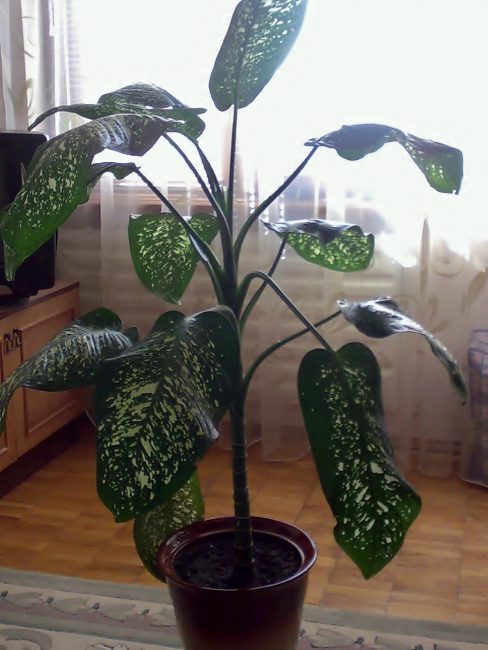
At home, it will not do harm if you handle it correctly.
The pot should be out of reach of children and animals. So that they do not accidentally try her leaves, which attract with their brightness.
Even a small piece of dieffenbachia can cause burns to the oral cavity and respiratory tract. If it enters the stomach, there is a risk of internal bleeding.
It is better to abandon the plant when a cat lives at home. It is very difficult to remove anything from them. Since they can climb into any hard-to-reach place. Its juice, entering the esophagus and stomach of a pet, can be fatal.
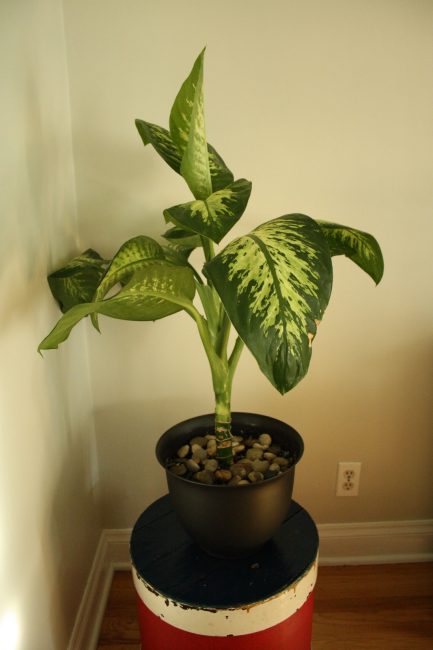
The plant is dangerous for allergy sufferers. With individual intolerance, it can cause heart failure.
There is a popular belief about dieffenbachia that it scares men away from the house. It is popularly called the “widow's flower”. Allegedly, her mistress, even if she creates a family, she will not be able to give birth.
Another interesting fact about the plant. In Africa he was nicknamed "the dumb rod". In a slave society, its leaves were forced to chew on slaves as punishment. The milky juice affected the larynx and mouth. The man could not speak. So they punished for arguing with the owner.
Despite beliefs and poisonous properties, it is common in homes. It is grown and cherished
The main thing is to observe all precautions in this process.

Pomegranate at home: growing from a stone and care, useful properties and contraindications (Photo & Video) + Reviews
Bloom
Dieffenbachia rarely blooms at home. It is valued not for flowers, but for beautiful leaves. The flower develops in spring in April-May. It develops for about 2 weeks and blooms for 3 days. It has the shape of a cob.
Florists advise removing the emerging flowers. They are ugly, and they take a lot of strength from the plant.
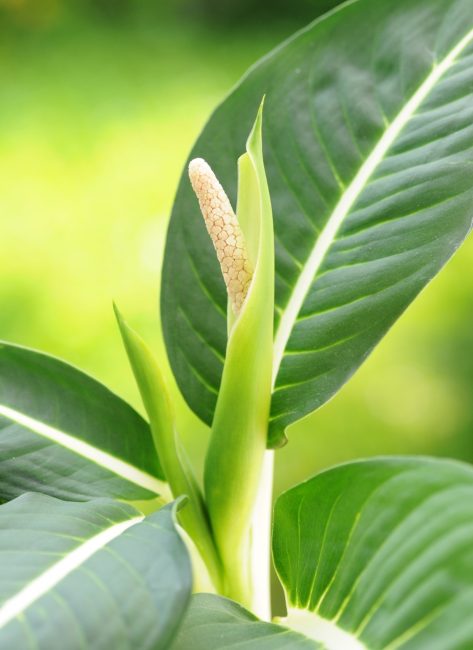
It smells of plastic with sweetish notes. If you leave it, then it is better to take it out of the living space.
If you want to see your Dieffenbachia blooming, you need to create a stressful environment for it. To do this, put in a well-lit place, but deprive it of fertilizer and watering. You need to torment the plant until the leaves sag.
Then it needs to be revived. Place in a container of water until the leaves come to their senses and a bud appears. After such a procedure, she should start.
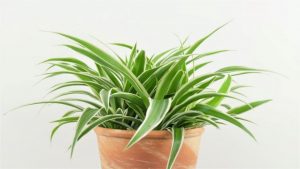
Chlorophytum home (120 Photos) - home care, reproduction, transplant, disease + Reviews
Dieffenbachia pests and diseases
Insects and Dieffenbachia Diseases
Of the insects, dieffenbachia is most often affected by spider mites, scale insects, aphids, thrips and mealybugs. Methods of dealing with them consist in the mechanical removal of pests with a damp sponge soaked in soapy water, followed by washing off the soap with plenty of water. In case of severe infection, treatment with a solution of actellik or karbofos is used in a proportion of 15 drops per liter of water.
Sometimes dieffenbachia suffers from bacteriosis, which manifests itself in the appearance of watery areas with clear boundaries on the leaves. Unfortunately, this disease is bacterial in nature, it is incurable. An adult plant can also be destroyed by root rot, which rot firstly affects the underground part of the plant, and then the ground one. As soon as you notice areas with a light gray bloom, take action immediately: reduce watering, replace the substrate, treat with a systemic fungicide.
Dieffenbachia turns yellow
Very often amateur flower growers ask the question why the leaves of Dieffenbachia turn yellow. To begin with, if you followed all the rules for caring for the plant, you would not have to find out why Dieffenbachia turns yellow, since proper care makes the plant invulnerable to diseases and pests. But in life, anything happens, so let's clarify this issue.
First of all, in such cases, the suspicion falls on a violation of the temperature regime: either the room is too cold, or the plant was in a draft... A possible reason is also watering the plant with too hard water or a lack of nutrients in the soil. Dieffenbachia leaves turn yellow due to root rot.
Dieffenbachia dries
Often our readers also ask why dieffenbachia dries. If the lower leaves dry, turn yellow and fall off, then this is a natural process, which, unfortunately, cannot be prevented, and if the trunk is very bare, then it is time to rejuvenate Dieffenbachia by cuttings. But if young leaves dry, then this is most likely due to insufficient watering for a long time, cold air or drafts.
Dieffenbachia withers
If the leaves are drooping and the substrate is dry, then you rarely water the plant, but if the substrate is wet and the leaves are drooping, check the roots for rot. If it is found, clean the roots from the ground, remove the rotten areas with a sharp, sterile instrument, treat the wounds with crushed charcoal or ground cinnamon and transplant the dieffenbachia into new soil. We will also have to revise the mode of plant moisture in the direction of reducing the amount of moisture or the frequency of watering.
Reproduction
Every owner of such a beautiful plant as Dieffenbachia should know how to reproduce it, so that when a bush grows, it can be renewed or just get a couple more young plants. There are several effective breeding methods, which we will talk about in more detail.
Apical cuttings
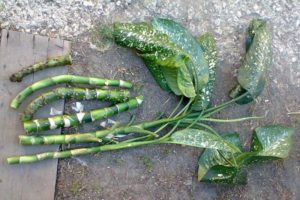 The instructions for propagation by apical cuttings are as follows:
The instructions for propagation by apical cuttings are as follows:
- Prepare cuttings 15 cm long by cutting them from the top of the bush.
- Perform rooting by placing the segments in a glass of water or planting them in a special substrate. To prepare the soil, mix equal proportions of peat and sand.
- Add an activated charcoal tablet to the water to disinfect the plant. After the formation of roots (3-4 cm in length), land in the ground.
- If the seedlings are rooting in the ground, then create a "greenhouse" for them, covering the container with a film.
Stem cuttings
This method is also simple:
- Cut the dieffenbachia trunk into cuttings 10-15 cm long.
- Treat the sections with activated carbon and dry them for 24 hours.
- Spread the planting material on the soil and sprinkle with soil so that half of the plant remains on the surface.
Expert opinion
Vera Ivanovna Sh
Since childhood, she was fond of cultivating indoor flowers, then decided to devote her life to landscape design and gardening.
Reproduction by stem cuttings takes a long time, becausethe plant takes root very slowly, sometimes throughout the year.
Leaves
Large leaves without any signs of disease are suitable for reproduction, but in no case are they old. The procedure is as follows:
- Select healthy leaves and cut them off the bush;
- Dry the leaves, and then put in a container with water;
- After the appearance of roots (about 2 cm), plant in the soil;
- Cover the seedlings with plastic. Further care should be taken according to general rules.
Leaves can be planted directly into the soil, however, with this method, root rot is possible.
By dividing the root
 Usually this method is used for a planned plant transplant. The instruction is as follows:
Usually this method is used for a planned plant transplant. The instruction is as follows:
Water the flower abundantly and carefully remove it from the pot so as not to damage the earthen ball; Rinse the roots with running water and gently untwist them; Examine the root system for the presence of gray rot and, if found, remove the infected areas; Dry the plants for 24 hours, then plant them in new soil. For disinfection of the roots, use crushed activated carbon or a weak solution of potassium permanganate
To disinfect the roots, use crushed activated carbon or a weak solution of potassium permanganate.
Caution - Dieffenbachia!
Despite its attractiveness, the cute tropical beauty belongs to the poisonous plants. The sap secreted by the plant causes minor damage to the skin. But if it gets on the mucous tissue of the mouth or eyes, a burn occurs. In rare cases, complete intoxication of the body can occur, which manifests itself as follows:
- swelling of the mouth tissues and lips;
- profuse saliva;
- rapid breathing;
- vomit;
- diarrhea;
- temperature increase;
- tearing.
First aid for dieffenbachy burns, and treatment consists of simple steps. First you need to rinse the affected skin area with running water. For painful sensations, a solution of lidocaine is applied to the burn. If the juice gets on the eyeball, wash the affected eye with running water for about 20 minutes. Then use drops "Levomycetin" or a solution of furacilin to prevent infection.
Burns resulting from dieffenbachia juice in the oral cavity are removed thanks to the rinsing procedure. A clearly expressed pain can be quenched with a solution of novocaine (0.5%). After these steps, it is recommended to drink a glass of cold milk or water.
In any case, when a problem arises, it is important not to waste time, but to act
Dieffenbachia care at home
Dieffenbachia, caring for which at home presents some difficulties, is still not as capricious as it is commonly believed. Dieffenbachia flower does not tolerate sudden temperature fluctuations. The most acceptable ambient temperature is + 20..25 ° С. In winter, not lower than + 17 ° С. The best air humidity is 70-80%, so the leaves should be sprayed frequently and washed once every two weeks.
This plant loves fresh air, but does not tolerate drafts. In summer, she feels good on the balcony, if there is a shady corner for her, and the rooms where dieffenbachia lives should be regularly ventilated.
Dieffenbachia spotted loves light, but does not tolerate open sunlight, so in winter it must be kept in bright light, and in summer in partial shade. There are varieties of Dieffenbachia that are quite shade-tolerant, which allows them to be used in poorly lit interiors.
The soil in the dieffenbachia pot should always be moist, but not too wet. Waterlogging of the soil is especially dangerous at low temperatures. This can cause rotting of the roots and stems of the plant. Warm settled water is suitable for irrigation. During the growth period, from spring to autumn, dieffenbachia should be occasionally fed with fertilizers, and in winter, watering and feeding should be reduced, but the earthen coma in the pot should not dry out.
In rooms, some dieffenbachia can grow up to 2 meters, and when watering is insufficient, the lower leaves fall off and the plant becomes like a palm tree.In an old plant, the lower leaves die off and dry up, which is natural, and there is nothing to worry about. If the appearance of a bare-stemmed plant does not suit you, cut the stem to a height of 10 centimeters from the root, dieffenbachia will give young shoots, and the top can be rooted.
Dieffenbachia, the transplant of which became necessary due to the suspension of growth or due to a disease of the plant, is transplanted into a new pot with an earthen mixture consisting of turf, peat soil and sand in a ratio of 2: 4: 1. At the same time, damaged areas are removed and treated with charcoal. Planned dieffenbachia is transplanted annually in the spring. At the same time, the size of the pot is increased, and they do not forget to put drainage from broken bricks, etc. on the bottom of the pot.
 Dieffenbachia spotted, or Dieffenbachia seguine (Dieffenbachia seguine). Hernán Conejeros
Dieffenbachia spotted, or Dieffenbachia seguine (Dieffenbachia seguine). Hernán Conejeros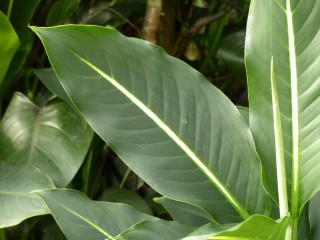 Dieffenbachia Oerstedii. Andrea Moro
Dieffenbachia Oerstedii. Andrea Moro


